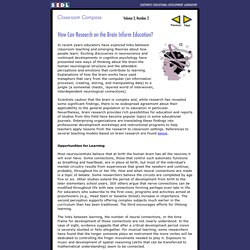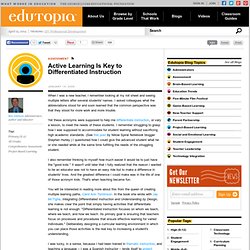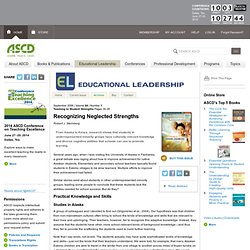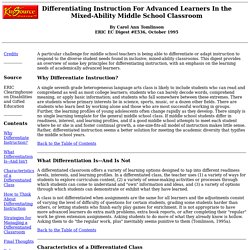

Differentiated Instruction with UDL. By Tracey Hall, Nicole Strangman, and Anne Meyer Note: Updated on 11/2/09; 1/14/11; Please visit the AIM Center home page.

Introduction Not all students are alike. Based on this knowledge, differentiated instruction applies an approach to teaching and learning that gives students multiple options for taking in information and making sense of ideas. Differentiated instruction is a teaching theory based on the premise that instructional approaches should vary and be adapted in relation to individual and diverse students in classrooms (Tomlinson, 2001). This report on differentiated instruction and UDL begins with an introduction to differentiated instruction in which we provide the definition, a sampling of considerations and curriculum applications, and research evidence for effectiveness. The literature review in this paper is also available as a stand alone document, with annotated references. Top Definition Figure 1. Identifying Components/Features Content Process Products Figure 2. SCIMAST Classroom Compass. In recent years educators have explored links between classroom teaching and emerging theories about how people learn.

Exciting discoveries in neuroscience and continued developments in cognitive psychology have presented new ways of thinking about the brain-the human neurological structure and the attendant perceptions and emotions that contribute to learning. Explanations of how the brain works have used metaphors that vary from the computer (an information processor, creating, storing, and manipulating data) to a jungle (a somewhat chaotic, layered world of interwoven, interdependent neurological connections). Scientists caution that the brain is complex and, while research has revealed some significant findings, there is no widespread agreement about their applicability to the general population or to education in particular.
Opportunities for Learning Most neuroscientists believe that at birth the human brain has all the neurons it will ever have. Emotions and the Mind Caine, R. Active Learning Is Key to Differentiated Instruction. When I was a new teacher, I remember looking at my roll sheet and seeing multiple letters after several students' names.

I asked colleagues what the abbreviations stood for and soon learned that the common perspective was that they stood for more work and more trouble. Yet these acronyms were supposed to help me differentiate instruction, or vary a lesson, to meet the needs of these students. I remember struggling to grasp how I was supposed to accommodate for student learning without sacrificing high academic standards. (See this post by fellow Spiral Notebook blogger Stephen Hurley.) I questioned how I could give the advanced student what he or she needed while at the same time fulfilling the needs of the struggling student. I also remember thinking to myself how much easier it would be to just have the "good kids. " You will be interested in reading more about this from the queen of creating multiple learning paths, Carol Ann Tomlinson.
Finding the Right Match Give Them Options. Leveraging Technology to Differentiate Instruction. Teaching to Student Strengths:Recognizing Neglected Strengths. Robert J.

Sternberg A group of colleagues and I decided to find out (Grigorenko et al., 2004). Our hypothesis was that children from non-mainstream cultures often bring to school the kinds of knowledge and skills that are relevant to their lives and upbringing. Their teachers, however, fail to recognize this adaptive knowledge. Instead, they assume that the students have other, more school-relevant kinds of background knowledge—and thus they fail to provide the scaffolding the students need to build further learning. Note that I say kinds, not levels. To find out how this kind of adaptive knowledge relates to students' test performance, we assessed the practical knowledge and skills of 261 students in grades 9–12 in southwestern Alaska.
When Eddie runs to collect the ptarmigan that he's just shot, he notices that its front pouch (balloon) is full of food. There's a storm on the way. Uncle Markus knows a lot about hunting wolverines. On a slanted tree. Figure 1. A Study in Kenya. Differentiating Instruction For the Gifted. How to Think About Differentiating Instruction There are many ways to shake up the classroom to create a better fit for more learners-including those who are advanced.

In general, interest-based adjustments allow students to have a voice in deciding whether they will apply key principles being studied to math-oriented, literature-based, hobby-related, science-oriented, or history-associated areas. For example, in studying the American Revolution, one student might opt to write a short story about the life of a teenager during the Revolutionary period.
Another might elect to apply key ideas about the American Revolution to an investigation of heroes then and now. Yet another might prefer to study ways in which the Revolution affected the development of science. Adjustments based on learning profile encourage students to understand their own learning preferences. Concrete to abstract.
Strategies for Managing a Differentiated Classroom Final Thoughts Back to the Table of Contents References.